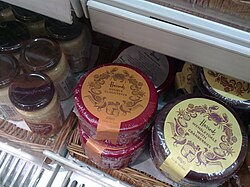Gloucester cheese
| Gloucester | |
|---|---|
 | |
| Country of origin | England |
| Region | Gloucestershire |
| Source of milk | Traditionally from Gloucester cattle |
| Pasteurised | Traditionally no |
| Texture | semi-hard |
| Aging time | 36 weeks |
| Certification | Single Gloucester: PDO |
| Named after | Gloucester |
Gloucester is a traditional, semi-hard cheese which has been made in Gloucestershire, England, since the 16th century. There are two varieties of the cheese, Single and Double; both are traditionally made from milk from Gloucester cattle. Both types have a natural rind and a hard texture, but Single Gloucester is more crumbly, lighter in texture and lower in fat. Double Gloucester is allowed to age for longer periods than Single, and it has a stronger and more savoury flavour. It is also slightly firmer. The flower known as lady's bedstraw (Galium verum) was responsible for the distinctively yellow colour of Double Gloucester cheese.
In the United Kingdom today, Double Gloucester is more widely sold. Both types are produced in round shapes, but Double Gloucester rounds are larger. Traditionally whereas the Double Gloucester was a prized cheese comparable in quality to the best Cheddar or Cheshire, and was exported out of the county, Single Gloucester tended to be consumed within Gloucestershire.
Most Double Gloucester sold in UK supermarkets is slab cheese, made in large creameries operated by major dairy companies such as Dairy Crest. Supermarkets normally sell Double Gloucester under their own store brand. This version of the cheese is pasteurised, but not processed.
Revival of Farmhouse Gloucester
[edit]Manufacture of traditional Gloucester cheeses from the Gloucester cow died out in the 1950s along with most of the Gloucester cattle.[1] However, in 1973 Charles Martell managed to gather 3 Old Gloucester cows[2] from the herd of less than 50 left in the county.[1] A BBC TV series A Taste of Britain filmed his successful attempt to revive the tradition of farmhouse Double Gloucester that year.[3] In 1978 Charles Martell went on to revive the lost single Gloucester cheese.[2] Traditionally produced Gloucester cheese has been supported by the Slow Food movement since 2004.[4] Single Gloucester cheese has Protected Designation of Origin and can only be made in Gloucestershire on farms with Gloucester cows. As of 2010 six cheese makers are producing this cheese.[5]
Variations
[edit]
Double Gloucester is often blended with other ingredients. One variety made by blending with chives and spring onions has been marketed as Cotswold cheese, though this is not a traditional English cheese name.[6][7] This cheese is supposedly coloured similarly to Cotswold stone.[8]
Huntsman cheese, also known as Stilchester, is made with alternating layers of Double Gloucester and Stilton.
Origin of double and single names
[edit]The reason for the two types of Gloucester cheese being called 'double' and 'single' is not known. The main theories are:
- because the creamy milk had to be skimmed twice to make the double variety, or
- because cream from the morning milk was added to the evening milk, or
- because a Double Gloucester cheese is typically twice the height.[9][10]
Cheese-rolling
[edit]A wheel of Double Gloucester cheese is also used every spring for the Cooper's Hill Cheese-Rolling and Wake, in which competitors chase the cheese down a steep Gloucestershire hillside; the first person to reach the bottom of the 50% gradient, 200 yards (180 m) slope wins the cheese.[11] The wheel has a one-second head start. During its roll, it can accelerate to speeds of at least 70 mph under the effects of gravity.[12][13]
References
[edit]- ^ a b Pearce, Pam (2 May 2018). "Say cheese - the history of Double Gloucester and Single Gloucester". GloucestershireLive. Archived from the original on 26 May 2021. Retrieved 28 June 2021.
- ^ a b "Charles Martell & Son - Cheesemakers and Distillers". www.charlesmartell.com. Archived from the original on 14 May 2021. Retrieved 28 June 2021.
- ^ "BBC Radio 4 - The Food Programme, A Taste of Britain: Revisited". BBC. Archived from the original on 26 May 2021. Retrieved 28 June 2021.
- ^ "Artisan Single and Double Gloucester Cheese". Archived from the original on 26 May 2021. Retrieved 28 June 2021.
- ^ "Charles Martell & Son - History of the Company and Farming in Gloucestershire". www.charlesmartell.com. Archived from the original on 26 May 2021. Retrieved 28 June 2021.
- ^ Jones, David E. H. (7 December 1978). "Ariadne". New Scientist. 80 (1132): 824. ISSN 0262-4079.
For cheese manufacturers, from some dying pressure of conscience perhaps, have taken to adding substances to cheese to give some counterfeit of flavour. For example, we now have Cotswold, a cheese with chives in it.
- ^ Widcombe, Richard (1978), The Cheese Book, Chartwell Books, p. 57, ISBN 9780890096628,
Background: This is one of several new varieties of English cheese flavoured with various additives. Description: Cotswold is a version of the traditional English cheese Double Gloucester with chives added. It has the smooth, mellow taste of the typical Gloucester with the chives imparting a fragrant, delicate, oniony flavour.
- ^ "Cotswold Cheese". Gourmet-food.com. Archived from the original on 29 August 2016. Retrieved 6 July 2013.
- ^ "Under the Spotlight: Double Gloucester". Belton Farm. 22 January 2019. Archived from the original on 22 April 2021. Retrieved 22 April 2021.
- ^ Pearce, Pam (17 May 2017). "The difference between Double Gloucester and Single Gloucester cheese". Gloucestershire Live. Archived from the original on 22 April 2021. Retrieved 22 April 2021.
- ^ "The Official Site of Cheese Rolling". Cheese-rolling.co.uk. Archived from the original on 15 March 2010. Retrieved 6 July 2013.
- ^ Maynard, Matt (22 May 2018). "In Conversation With a Cheese Chaser – Men's Running UK". Men's Running. Retrieved 9 October 2024.
- ^ Morris, Steven (27 May 2024). "'You just have to roll': Gloucestershire cheese-rolling race has international appeal". The Guardian. ISSN 0261-3077. Retrieved 9 October 2024.
